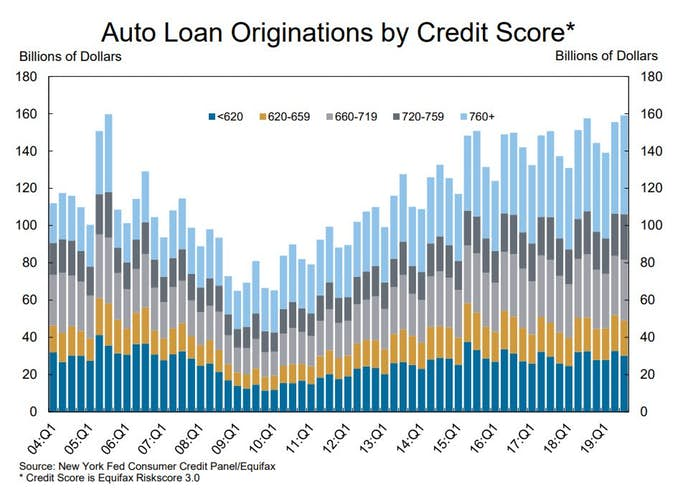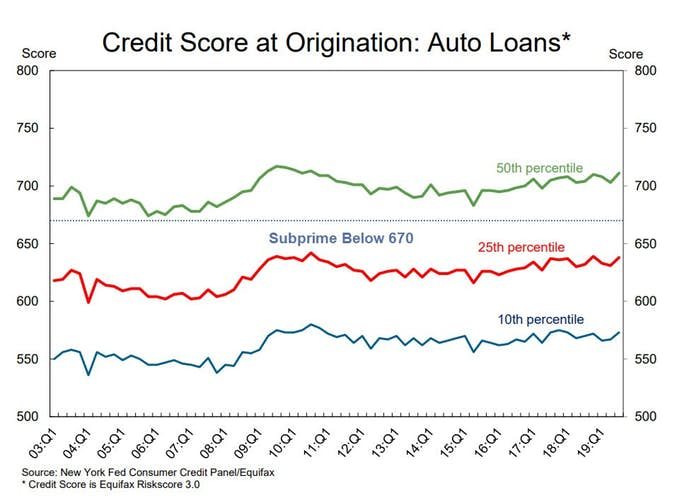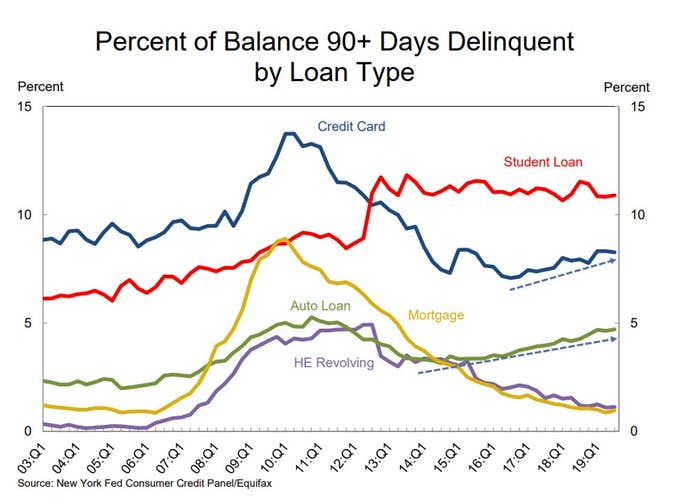The quarterly report on household debt shows another record high. Delinquencies are up strongly as well.
Let's dive into some stats and charts from the New York Fed Third-Quarter Report on Household Debt and Credit.
Key Points
- Aggregate household debt balances increased by $92 billion in the third quarter of 2019, a 0.7% increase, and now stand at 13.95 trillion.
- Balances have been steadily rising for five years and in aggregate are now $1.3 trillion higher, in nominal terms, than the previous peak (2008Q3) peak of $12.68 trillion. Overall household debt is now 25.1% above the 2013Q2 trough.
Mortgage balances shown on consumer credit reports on September 30 stood at $9.44 trillion, a $31 billion increase from 2019Q2. Balances on home equity lines of credit (HELOC) have been declining since 2009, and this quarter’s decline of $3 billion brings the outstanding balance to $396 billion. Non-housing balances increased by 64 billion in the third quarter, with increases across the board, including $18 billion in auto loans, $13 billion in credit card balances, and $20 billion in student loans.
New extensions of credit were strong for the third quarter. Auto loan originations, which include both newly opened loans and leases, remained high in the third quarter, at $159 billion, a small increase from the last quarter’s volume but the second highest ever observed. Mortgage originations, which we measure as appearances of new mortgage balances on consumer credit reports and which include refinances, were at $528 billion, a notable jump from the $445 billion seen in the same quarter last year. Aggregate credit limits on credit cards also increased, by $27 billion, continuing a 10-year upward trend.
- Credit standards tightened slightly in the third quarter.
The median credit score of newly originating borrowers increased in the third quarter for mortgages, to 765, a 6 point increase from the first half of the year. Auto loans also saw tightening in underwriting standards, with an 8 point increase in the median originating credit score. The origination volume remained high, with $30 billion in subprime originations, a level on par with the last several years.
Aggregate delinquency rates worsened in the third quarter of 2019. As of September 30, 4.8% of outstanding debt was in some stage of delinquency, a 0.4 percentage point increase from the second quarter due primarily to increases in early delinquency buckets. Of the $667 billion of debt that is delinquent, $424 billion is seriously delinquent (at least 90 days late or “severely derogatory”, which includes some debts that have previously been charged off that the lenders continue to attempt collection).
About 186,000 consumers had a bankruptcy notation added to their credit reports in 2019Q3, an improvement from the 215,000 in 2018Q3.
Auto Loan Originations
Credit Score at Auto Loan Origination
Percent of Balance 90+ Day Delinquent
Transition into Serious Auto Delinquency
Transition into Serious Credit Card Delinquency
Five Comments
- Delinquencies have been rising for 6-7 years in this allegedly booming economy where the unemployment rate is near record lows.
- Subprime auto loans account for well over 25% of auto loans.
- Subprime auto loan serious delinquencies are at or above where they were before the start of the Great Recession in all age groups.
- Credit card delinquencies for the 60-69, 50-59, and 40-49 age groups are at the level reached prior to the great recession.
- Writeoffs rate to be immense in any sort of sustained jobs downturn.
This material is based upon information that Sitka Pacific Capital Management considers reliable and endeavors to keep current, Sitka Pacific Capital Management does not assure that this material is accurate, current or complete, and it should not be relied upon as such.
Recommended Content
Editors’ Picks
EUR/USD holds steady near 1.0650 amid risk reset

EUR/USD is holding onto its recovery mode near 1.0650 in European trading on Friday. A recovery in risk sentiment is helping the pair, as the safe-haven US Dollar pares gains. Earlier today, reports of an Israeli strike inside Iran spooked markets.
GBP/USD recovers toward 1.2450 after UK Retail Sales data

GBP/USD is rebounding toward 1.2450 in early Europe on Friday, having tested 1.2400 after the UK Retail Sales volumes stagnated again in March, The pair recovers in tandem with risk sentiment, as traders take account of the likely Israel's missile strikes on Iran.
Gold price defends gains below $2,400 as geopolitical risks linger

Gold price is trading below $2,400 in European trading on Friday, holding its retreat from a fresh five-day high of $2,418. Despite the pullback, Gold price remains on track to book the fifth weekly gain in a row, supported by lingering Middle East geopolitical risks.
Bitcoin Weekly Forecast: BTC post-halving rally could be partially priced in Premium

Bitcoin price shows no signs of directional bias while it holds above $60,000. The fourth BTC halving is partially priced in, according to Deutsche Bank’s research.
Geopolitics once again take centre stage, as UK Retail Sales wither

Nearly a week to the day when Iran sent drones and missiles into Israel, Israel has retaliated and sent a missile into Iran. The initial reports caused a large uptick in the oil price.





